Crochet beanie size guides help crafters create hats that fit perfectly, from babies to adults. Understanding measurements ensures comfort and style, making your projects truly special.
Importance of Proper Sizing for Crochet Beanies
Proper sizing is crucial for crochet beanies to ensure comfort, functionality, and a flattering appearance. A well-fitted beanie stays in place without feeling too tight or slipping off, providing warmth and style. Incorrect sizing can lead to discomfort or a less appealing look. Measuring head circumference accurately ensures the beanie meets its intended purpose, whether for warmth, fashion, or as a gift. Using a size guide helps crafters achieve the right fit, making the project more enjoyable and satisfying. Proper sizing also enhances the recipient’s satisfaction, ensuring the beanie serves its purpose effectively.
Understanding Head Circumference Measurements
Head circumference is the most critical measurement for crochet beanies, ensuring a proper fit. It is measured around the widest part of the head, just above the eyebrows and ears. Accurate measurements are essential to match the size guide, as incorrect sizing can lead to a too-tight or too-loose fit. For adults, the average range is 20-24 inches, while babies and children have smaller circumferences. Using a flexible tape measure ensures precision. Properly fitting beanies stay comfortable and stylish, making head circumference the foundation of successful crochet projects. Measuring correctly guarantees the best results for any age group or style.
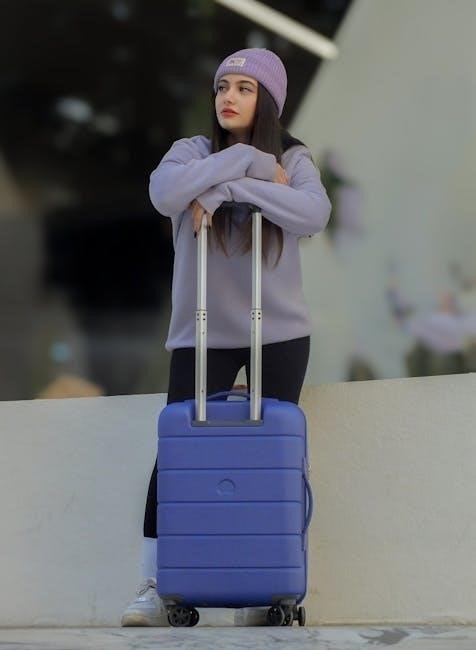
General Crochet Beanie Size Chart
The general crochet beanie size chart offers a comprehensive guide for all ages, from preemie to adult, ensuring a perfect fit with accurate measurements and stitch counts tailored to each size for optimal comfort and style.
Preemie and Baby Sizes
Preemie and baby sizes are crucial for ensuring a comfortable and snug fit for little ones. Preemie beanies typically range from 10 to 12 inches in head circumference, while newborn sizes are around 12-14 inches. Baby sizes (0-3 months) usually measure 14-15 inches, and 3-6 months range from 15-16 inches. These sizes are designed to accommodate the rapid growth of infants. When crocheting for preemies or babies, it’s important to consider yarn weight, hook size, and stitch tension to achieve the correct fit. Measuring the head circumference or using a standard size chart ensures accuracy. Starting with a preemie pattern and adjusting length as needed can also help achieve the perfect fit for these tiny heads. Always prioritize soft, breathable yarns for comfort and safety. These guidelines help crafters create adorable, well-fitting beanies for the youngest wearers. Proper sizing ensures both comfort and style, making these handmade gifts truly special. By following these measurements, you can ensure your crochet project turns out perfectly tailored for preemies and babies. This attention to detail makes handmade beanies a thoughtful and practical gift for new parents. Remember, accurate measurements and stitch counts are key to achieving the right fit for these delicate sizes. With these tips, you can confidently crochet beautiful, comfortable beanies for the littlest ones.
Child and Tween Sizes
Child and tween sizes are designed to fit growing heads comfortably, ensuring a snug yet roomy fit for active kids. Child sizes typically range from 18 to 20 inches in head circumference, suitable for ages 4-8 years, while tween sizes accommodate 20-22 inches for ages 9-12 years. These sizes are perfect for school-aged children and pre-teens, allowing for growth and comfort. When crocheting for this age group, consider the yarn weight and hook size to maintain the right tension. Soft, breathable yarns are ideal for sensitive scalps. Measuring the head or using a standard size chart ensures the best fit. Adjusting the pattern by adding or reducing stitches can customize the size further. This ensures the beanie stays comfortable and stylish as the child grows. Proper sizing is key to creating a hat that is both functional and fashionable for this age group. By following these guidelines, crafters can create beanies that are perfect for everyday wear or special occasions. Ensuring a good fit makes the beanie a practical and appreciated gift for children and tweens alike.
Adult Small, Medium, and Large Sizes
Adult crochet beanie sizes are categorized into Small, Medium, and Large to accommodate varying head circumferences. Small fits heads measuring 20-21 inches, Medium suits 21-22 inches, and Large is designed for 22-23 inches. These sizes ensure a comfortable, snug fit without being too tight. When crocheting for adults, consider yarn weight and hook size to maintain proper tension. Measuring the head or using a standard size chart is essential for accuracy. Adjusting patterns by adding or reducing stitches can further customize the fit. Using soft, breathable yarns enhances comfort, while stretchy stitches ensure the beanie stays snug. This range is versatile, catering to diverse preferences and head shapes. Ensuring the right size guarantees both style and comfort for adult beanies.
Universal Size Guide for All Ages
A universal size guide for crochet beanies simplifies the process by providing a standardized chart that suits all age groups. This approach ensures that crafters can easily adapt patterns to fit any size, from preemies to adults. By categorizing sizes based on head circumference, the guide offers a flexible framework for creating beanies. It typically includes measurements in inches or centimeters, allowing crafters to choose the right size effortlessly. This universal system is particularly useful for beginners or those crafting for unknown recipients. It promotes consistency and accuracy, making the crocheting process more enjoyable and efficient for everyone involved.
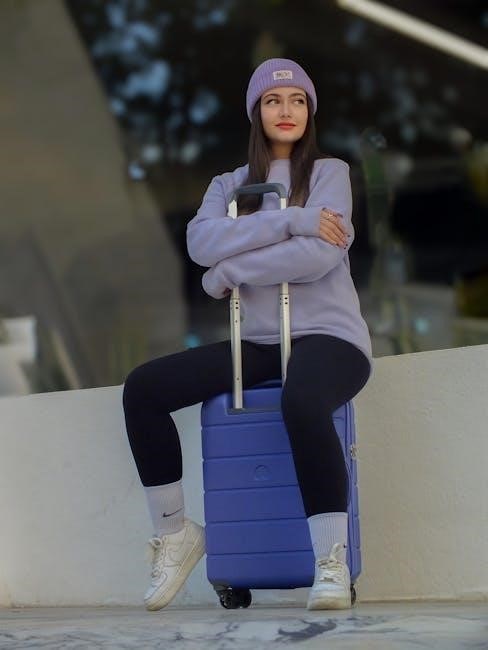
Factors Affecting Beanie Size
Beanie size is influenced by yarn weight, hook size, and stitch tension, which impact fabric stretchiness and overall fit, ensuring a comfortable and stylish crochet project.
Yarn Weight and Fiber Type
Yarn weight and fiber type significantly impact the fit of a crochet beanie. Chunky yarns create thicker fabrics, reducing stretch, while lighter yarns offer more flexibility. Natural fibers like cotton or wool provide different drape and elasticity compared to acrylics. The choice of yarn affects the overall size and comfort of the beanie, making it essential to select the appropriate type based on the desired style and season; Understanding how yarn weight influences stitch tension is crucial for achieving the perfect fit. Always consider the yarn’s properties when adjusting patterns to ensure the beanie meets the intended measurements and comfort level.
Hook Size and Tension
Hook size and tension are critical factors in achieving the correct size and fit of a crochet beanie. A larger hook can create looser stitches, resulting in a slouchier or oversized fit, while a smaller hook produces tighter stitches for a more fitted beanie. Tension, or how tightly you crochet, also plays a significant role. If your tension is too tight, the beanie may be smaller than intended, and if too loose, it may be too large. To ensure accuracy, it’s essential to swatch and measure your stitches before starting the project. Adjusting hook size or tension can help achieve the desired measurements for a perfect fit.
Stretchiness and Ease of the Fabric
The stretchiness and ease of the fabric significantly impact the fit of a crochet beanie. Yarns with high elasticity, like those containing wool or bamboo, provide excellent stretch, ensuring a comfortable fit without being too tight or restrictive. Beanies with less stretch may require precise sizing to avoid discomfort. Patterns that include ribbing or textured stitches can enhance elasticity, while denser fabrics offer stability. Understanding the stretchiness of your yarn ensures the beanie maintains its shape while accommodating head sizes comfortably. Proper ease ensures the hat sits well without puckering or being overly loose, making it essential for both aesthetics and functionality;
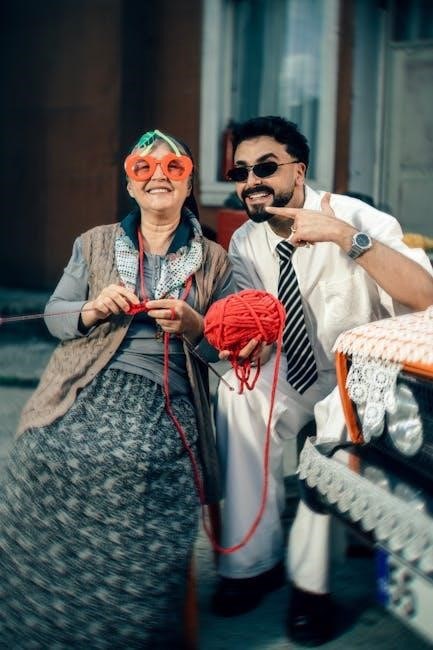
How to Measure Head Circumference
Measure around the widest part of the head, just above the eyebrows and ears, ensuring the tape stays level for accurate sizing and the best fit.
Step-by-Step Measuring Guide
To measure head circumference accurately, use a flexible tape measure. Wrap it around the widest part of the head, just above the eyebrows and ears. Ensure the tape is level and not too tight or loose. This ensures the beanie will fit comfortably and maintain its shape. Record the measurement in inches or centimeters. For best results, measure multiple times and take the average. This step is crucial for ensuring your crochet beanie fits perfectly, whether for a baby, child, or adult. Proper measurement guarantees comfort and style, making your handmade project truly special and tailored to the individual.
Using a Tape Measure for Accuracy
A tape measure is essential for ensuring accurate head circumference measurements. To use it effectively, wrap the tape around the widest part of the head, just above the eyebrows and ears. The tape should be level and not too tight or loose. This method works for all ages, from babies to adults, and ensures a comfortable, well-fitting beanie. For consistency, take multiple measurements and use the average. This step is crucial for matching your crochet project to the intended size, whether you’re creating for a newborn or an adult. Accurate measuring guarantees your beanie will be both stylish and comfortable, making it a perfect fit every time.
Converting Measurements to Hat Sizes
Converting head measurements to hat sizes is straightforward using a size chart. Once you have the circumference, match it to the corresponding size range. For example, a 20-inch head typically fits a small adult size. Newborns, toddlers, and children have specific ranges, while adults are categorized into small, medium, and large. This method ensures the beanie fits comfortably and meets style expectations. Always consider the intended wearer’s age and head size for accurate conversion. This step guarantees your crochet project will be both functional and fashionable, making it a thoughtful creation for any recipient.
Customizing Beanie Sizes
Adjusting length, adding or reducing stitches, and modifying patterns allow you to customize beanies for perfect fit and personal style. Ensure measurements match the intended wearer.
Adjusting Length for Different Styles
Adjusting the length of your crochet beanie allows you to achieve various styles, from slouchy to fitted. Start by crocheting the main body of the hat to the desired circumference. For a slouchy look, continue adding rounds to increase the length, creating a relaxed, oversized appearance. For a fitted beanie, stop once the hat reaches just above the ears. To add a brim, crochet additional rows and fold them up for a stylish touch. Always measure your work against a size guide to ensure proper fit and proportions. This customization ensures your beanie matches both the intended style and the wearer’s preferences perfectly.
Adding or Reducing Stitches for Fit
Adjusting the number of stitches is key to achieving the perfect fit in your crochet beanie. Adding stitches increases the hat’s circumference, ideal for larger sizes or looser fits. Conversely, reducing stitches creates a snugger fit, suitable for smaller sizes or tighter styles. To add stitches, simply increase the starting chain or add more stitches during the initial round. To reduce, decrease the starting chain or work fewer stitches. Ensure even distribution to maintain the hat’s shape. Always refer to a size guide to determine the correct number of stitches for the desired fit. This ensures your beanie is comfortable and visually appealing, tailored to the wearer’s needs.
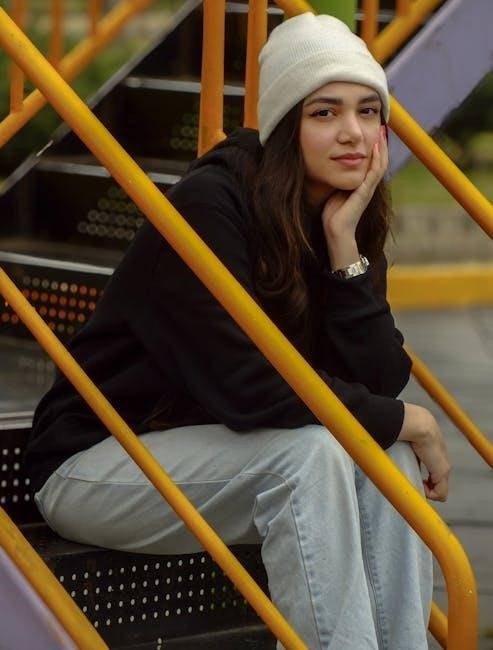
Modifying Patterns for Personal Preference
Modifying crochet patterns allows you to tailor beanies to suit individual tastes and preferences. Common adjustments include changing brim styles, adding texture with cables, or incorporating slouch for a trendier look. You can also alter the length for a fitted or oversized design. To personalize, consider swapping yarn weights or colors to match the recipient’s style. Adjusting stitch patterns, like adding ribbing or lace, enhances both aesthetics and fit. Always ensure modifications align with the intended head circumference to maintain comfort. By tweaking details, you create unique, bespoke beanies that reflect personal flair while adhering to essential sizing guidelines for the best fit.
Crochet Beanie Size Chart for Babies
This chart provides head circumference measurements for newborns, babies, and toddlers, ensuring a snug, comfortable fit while allowing for growth and style preferences.
Newborn Beanie Sizes (0-3 Months)
Newborn beanie sizes typically range from 12 to 14 inches in head circumference, with hat diameters around 6-7 inches. This ensures a snug, comfortable fit. Patterns often start with a small number of stitches, gradually increasing to form a soft, cozy shape. Using lightweight yarn and smaller hooks (4-5mm) is recommended for newborn beanies. Measure the baby’s head or use a size chart for accuracy. The length of the beanie usually measures 6-8 inches, providing full coverage without being too bulky. Proper sizing is crucial for both comfort and appearance, ensuring the hat stays in place while allowing for growth. These sizes are ideal for gifts or everyday use, offering a practical yet adorable solution for newborns.
Baby Beanie Sizes (3-6 Months)
Baby beanie sizes for 3-6 months typically range from 14 to 15 inches in head circumference, with hat diameters around 7-7.5 inches. The length usually measures 7-9 inches, providing adequate coverage while allowing for growth. Patterns often start with a slightly larger foundation than newborn sizes, ensuring a snug yet comfortable fit. Using a tape measure to determine the baby’s head size is recommended for accuracy. For this age group, medium-weight yarn and a 5-6mm hook are commonly used. Adjusting the number of starting stitches or rows can help achieve the perfect fit. Always consider the baby’s comfort and ensure the beanie is not too tight, as it may cause discomfort. These sizes are ideal for seasonal changes or everyday wear, offering both style and functionality for growing babies.
Toddler Beanie Sizes (1-3 Years)
Toddler beanie sizes for 1-3 years typically range from 18 to 20 inches in head circumference, with hat diameters around 7.5-8.5 inches. The length usually measures 8-10 inches, providing a comfortable fit that allows for growth. Patterns for this age group often start with a slightly larger foundation than baby sizes, ensuring a snug yet comfortable fit. Using a tape measure to determine the toddler’s head size is recommended for accuracy. For this age group, medium to bulky yarn with a 6-7mm hook is commonly used. Adjusting the number of starting stitches or rows can help achieve the perfect fit. These sizes are ideal for seasonal changes or everyday wear, offering both style and functionality for active toddlers.

Crochet Beanie Size Chart for Children
Children’s sizes range from 4-8 years, with head circumferences of 19-20.5 inches and hat lengths of 9-10 inches for a comfortable, growth-friendly fit.
Child Beanie Sizes (4-8 Years)
For children aged 4-8 years, crochet beanies typically fit head circumferences of 19-20.5 inches. The hat length usually ranges from 9-10 inches, ensuring a comfortable fit while allowing for growth. Patterns often include stitch counts and hook sizes tailored to these measurements, ensuring the beanie is neither too tight nor too loose. Yarn weight and type play a significant role in achieving the desired drape and warmth. Adjusting the length or stitch count can customize the fit further, making it suitable for varying head sizes within this age group. Always measure the recipient’s head or refer to standard size charts for accuracy.
Tween Beanie Sizes (9-12 Years)
For tweens aged 9-12 years, crochet beanies typically fit head circumferences of 20-22 inches. The hat length usually ranges from 9.5 to 10.5 inches, providing a comfortable, slouchy fit. Patterns for this age group often include stitch counts and hook sizes tailored to these measurements, ensuring the beanie is neither too tight nor too loose. Yarn weight and type significantly impact the drape and warmth, while the stretchiness of the fabric ensures a snug yet comfortable fit. Adjusting the length or stitch count can further customize the fit for individual preferences or head sizes within this range.
Teen Beanie Sizes (13+ Years)
Teen beanies, suitable for individuals aged 13 and above, typically accommodate head circumferences of 21 to 22.5 inches. Hat lengths generally range from 10 to 11 inches, offering a versatile fit that works for both casual and stylish looks. Patterns for this age group often include slightly larger stitch counts and hook sizes compared to younger children, ensuring a comfortable fit without being overly tight. Yarn weight and type play a crucial role in achieving the desired drape and warmth. To ensure the best fit, consider measuring the individual’s head and adjusting the pattern accordingly, allowing for a bit of ease while maintaining the desired style.

Crochet Beanie Size Chart for Adults
Adult crochet beanies range from Small (20-21 inches) to Medium (21.5-22 inches) and Large (22.5-23 inches), offering a tailored fit for different head sizes and styles, ensuring comfort and style.
Small Adult Beanie Sizes
Small adult beanies typically fit head circumferences ranging from 20 to 21 inches. This size is ideal for individuals with smaller head sizes or those who prefer a snug, fitted beanie. The patterns for small adult beanies usually start with a foundation chain of around 45-49 stitches, depending on the yarn weight and desired stretch. To ensure a proper fit, it’s essential to measure the head circumference accurately and adjust the number of starting stitches or rounds accordingly. A small beanie works well for both casual and dressy styles, making it versatile for various occasions. Always consider the yarn’s stretchiness and your crochet tension when creating a small adult beanie for the best results.
Medium Adult Beanie Sizes
Medium adult beanies are designed to fit head circumferences of approximately 21 to 23 inches, making them the most common size for average adult heads. Patterns typically begin with a foundation chain of 49-53 stitches, accommodating a variety of yarn weights and styles. This size offers a balanced fit, neither too tight nor too loose, and suits most adults comfortably. When crocheting a medium beanie, ensure to maintain consistent tension to achieve the desired fit. Adjustable patterns allow for customization, such as adding or reducing stitches, to ensure the beanie meets individual preferences. This versatility makes medium adult beanies a popular choice for both personal projects and gifts.
Large Adult Beanie Sizes
Large adult beanies are designed for head circumferences of approximately 23.5 to 24.5 inches, offering a comfortable fit for larger heads or those preferring a looser style. Patterns typically start with a foundation chain of 55-59 stitches, accommodating thicker yarns or relaxed tension. This size is ideal for adults with larger head sizes or for creating slouchy, oversized beanies. When crocheting a large beanie, consider adjusting the number of increase rounds or stitches to ensure the desired fit. This size is versatile, suiting both casual and stylish designs, making it a great option for personalized or gift projects tailored to individual preferences.

Understanding Negative Ease in Crochet
Negative ease ensures a snug fit by creating garments slightly smaller than body measurements. It’s crucial for proper fit in crochet projects like beanies, ensuring comfort and functionality.
What is Negative Ease?
Negative ease refers to the difference between a garment’s measurements and the body’s actual dimensions, ensuring a snug, tailored fit. In crochet, it’s crucial for items like beanies, where a small reduction in size ensures the hat stays in place and maintains its shape. Calculated by subtracting a few inches from the head circumference, negative ease allows for a comfortable yet secure fit. Proper negative ease ensures the fabric doesn’t stretch excessively, preserving both functionality and aesthetic appeal. Understanding and applying negative ease correctly is essential for achieving professional-looking crochet projects that are both practical and visually appealing.
How to Calculate Negative Ease for Beanies
To calculate negative ease for beanies, start by measuring the head circumference. Subtract 1-2 inches (2.5-5 cm) from this measurement to ensure a snug fit. For example, if the head measures 22 inches, aim for a beanie circumference of 20-21 inches. This allows the fabric to hug the head without stretching excessively. Divide the adjusted measurement by π (approximately 3.14) to determine the ideal diameter of the beanie. Negative ease ensures the hat stays in place and maintains its shape, especially for slouchy or fitted styles. Adjust the ease based on yarn weight and desired fit to achieve the perfect balance between comfort and style.
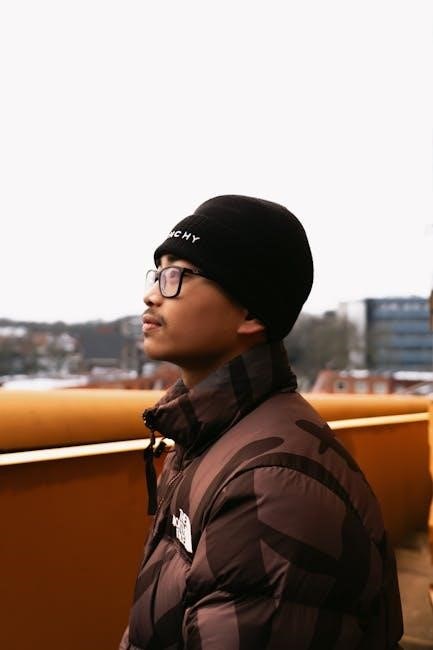
Troubleshooting Common Sizing Issues
Common sizing issues in crochet beanies often stem from incorrect measurements or yarn choices. Adjusting hook size or stitch count can help achieve the desired fit and style.
Hats That Are Too Tight or Too Loose
Hats that are too tight can cause discomfort, while those too loose may not stay on properly. To fix a tight hat, try using a larger hook or adding stitches. For a loose fit, switch to a smaller hook or reduce the number of stitches. Ensuring accurate head circumference measurements and proper tension while crocheting can prevent these issues. Adjustments can be made mid-project by checking the fit against the intended size guide. Proper yarn choice and understanding negative ease are also crucial for achieving the perfect fit. Regularly measuring your work ensures your beanie turns out comfortable and stylish.
Adjusting Patterns for Different Yarns
Different yarns vary in weight, fiber, and stretch, which can affect the fit of your crochet beanie. Thicker yarns create a denser fabric, while lighter yarns produce a looser weave. Always match the recommended yarn weight to the pattern. If substituting yarn, adjust the hook size to maintain proper tension and gauge. For example, a bulky yarn may require a larger hook, while a fine yarn needs a smaller one. Swatching is essential to ensure the fabric drapes correctly. Consider the yarn’s fiber content, as cotton and wool behave differently. By adjusting your yarn choice and hook size, you can achieve the perfect fit for any beanie pattern.
Fixing Sizing Mistakes Mid-Project
If you notice your beanie is too small or large while crocheting, don’t panic! Regularly measure your work against the size chart to catch issues early. If the circumference is off, adjust by adding or removing stitches in the next round. For a too-small hat, increase the stitch count or switch to a larger hook. If it’s too big, decrease stitches or use a smaller hook. Ensure even tension by checking your gauge. For rippling or uneven fabric, adjust stitch patterns or yarn weight. Fixing mid-project saves time and avoids major rework later. Swatch often and measure consistently for a perfect fit.
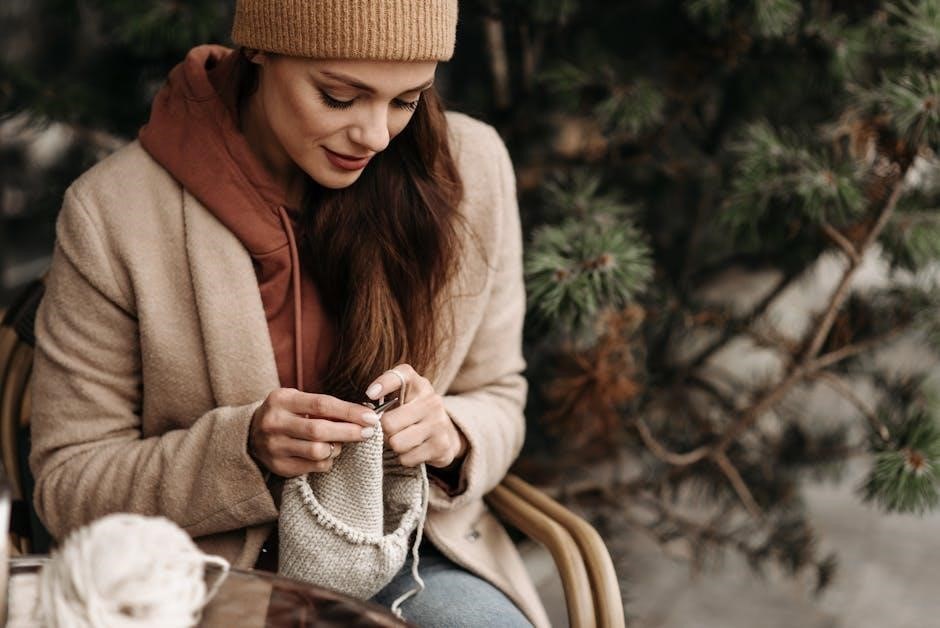
Additional Resources for Crochet Beanie Sizing
Find printable charts, online calculators, and tutorials for precise sizing. Join crochet communities for tips and access workshops to master custom fits and troubleshooting techniques easily.
Printable Crochet Beanie Size Charts
Printable crochet beanie size charts are invaluable tools for ensuring accurate sizing. They provide clear, organized measurements for various ages and head sizes, from newborns to adults. These charts often include circumference measurements in inches and centimeters, along with corresponding hat sizes. Many charts are designed to be laminated or saved digitally for easy reference. They simplify the process of matching yarn weight, hook size, and stitch count to achieve the perfect fit. Whether you’re a beginner or an experienced crocheter, printable charts save time and reduce guesswork, ensuring your beanies are comfortable and stylish for every recipient.
Online Tools for Calculating Hat Sizes
Online tools for calculating hat sizes are fantastic resources for crocheters, offering precise measurements and stitch counts. These tools often allow users to input head circumference, yarn weight, and hook size to determine the perfect fit. Many websites provide interactive calculators that generate custom patterns or adjustments based on specific requirements. Additionally, some platforms offer printable charts and video tutorials to guide users through the sizing process. These tools are especially useful for ensuring accuracy and saving time, whether you’re making a beanie for a newborn or an adult. They also cater to different styles, such as slouch hats or beanies with earflaps, making customization effortless.
Workshops and Tutorials for Perfect Fit
Workshops and tutorials are excellent resources for mastering crochet beanie sizing. These interactive sessions provide hands-on learning, covering topics like head measurement techniques, customizing patterns, and achieving the perfect fit. Many workshops include step-by-step guides and visual demonstrations, making complex concepts easy to understand. Expert instructors often share tips for adjusting stitch counts, understanding yarn weight, and ensuring proper ease. Whether you’re a beginner or an experienced crocheter, these resources help refine your skills and confidence. Online platforms offer live classes, pre-recorded tutorials, and interactive Q&A sessions, ensuring flexible learning opportunities. They’re a great way to troubleshoot common sizing issues and elevate your crochet projects to the next level.